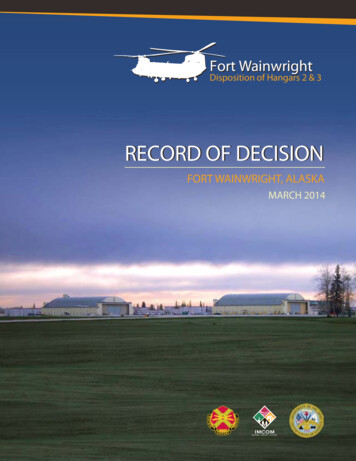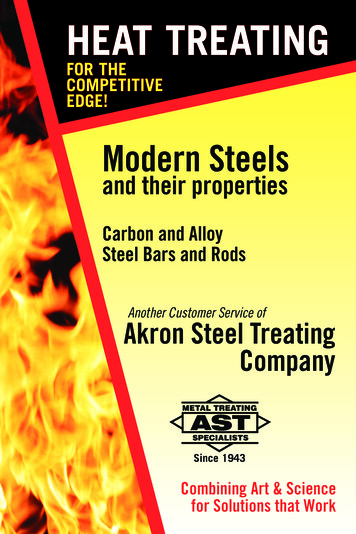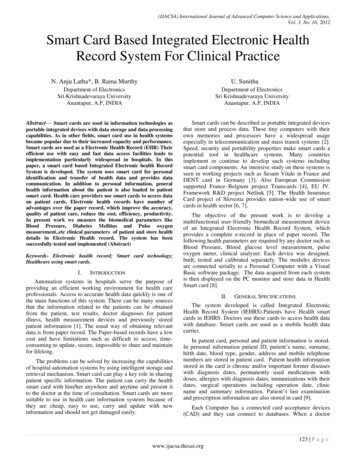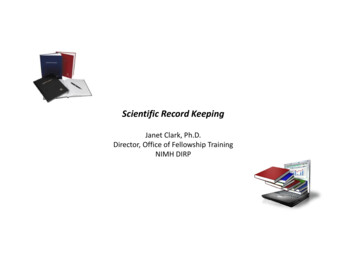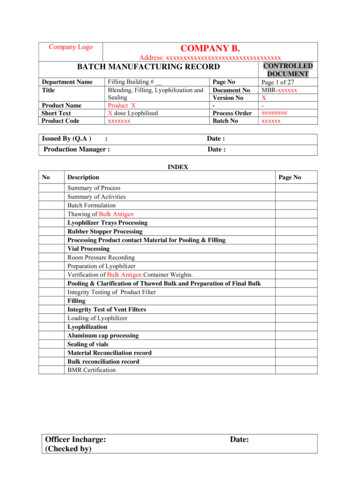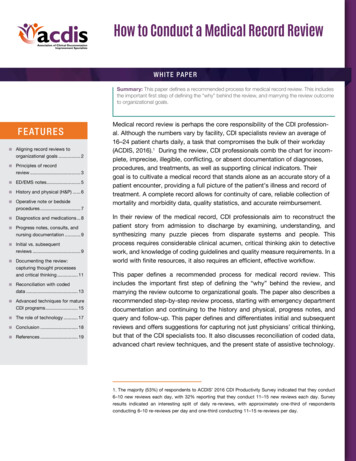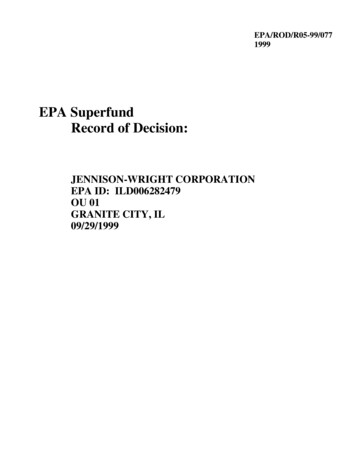
Transcription
EPA/ROD/R05-99/0771999EPA SuperfundRecord of Decision:JENNISON-WRIGHT CORPORATIONEPA ID: ILD006282479OU 01GRANITE CITY, IL09/29/1999
Jennison Wright Superfund Site, ILDECLARATION FOR THERECORD OF DECISIONSITE NAME AND LOCATIONJennison Wright Superfund SiteGranite City, IllinoisSTATEMENT OF BASIS AND PURPOSEThis decision document represents the selected remedial action for the Jennison WrightSuperfund Site developed in accordance with the Comprehensive Environmental Response,Compensation and liability Act of 1980 (CERCLA), as amended by the SuperfundAmendments and Reauthorization Act of 1986 (SARA) and, to the extent practicable, theNational Oil and Hazardous Substances Pollution Contingency Plan (NCP).This decision is based upon the contents of the administrative record for the Jennison WrightSuperfund Site.The United States Environmental Protection Agency (USEPA), Region V supports theselected remedy on the Jennison Wright Superfund site.ASSESSMENT OF THE SITEThe response action selected in the Record of Decision is necessary to protect the publichealth or welfare or the environment from actual or threatened releases of hazardoussubstances into the environment.DESCRIPTION OF SELECTED REMEDYThe selected remedy is comprised of treatment options in five operable units. This remedycomprises the overall remedy for the entire site. For site wastes consisting of the drip track residue and the oils found on-site,the selected alternative is to remove the waste and have it disposed at ahazardous waste facility.1
For site soils, a landfarm will be, constructed in the northeast portion of thesite. For NAPL removal, hot water and steam flushing is the selected alternativeover surfactant flushing because it is a more proven technology. For the more highly contaminated groundwater plumes, the preferredalternative is enhanced in situ biological treatment using Oxygen ReleaseCompounds (ORC) and air sparinging rather than natural attenuation and exsitu biological treatment. Natural attenuation is the selected alternative for theother areas of the site where the groundwater contamination is at a much lowerlevel. The buildings and other structures on the site will be razed and the asbestoscontaining materials inside will be abated. The selected alternative for the “Miscellaneous Items” category is to removethe remaining miscellaneous items (debris pile, storage tanks, abandoned steeltrams and several sumps and pits) that litter the site.STATUTORY DETERMINATIONSIt is the considered opinion of the Illinois Environmental Protection Agency (Illinios EPA) inconsultation with USEPA Region V that the selected remedy is protective of human healthand the environment, attains Federal and State requirements that am applicable or relevantand appropriate for this remedial action (or invokes an appropriate waiver), is cost-effective,and utilizes permanent solutions and alternative treatment technologies (or resource recovery)to the maximum extent practicable, and satisfies the statutory preference for remedies thatemploy treatment that reduces toxicity, mobility, or volume as a principal element. Becausethis remedy will result in hazardous substances remaining on-site above levels that will allowfor unlimited use and unrestricted exposure a statutory review will be conducted within fiveyears after initiation of remedial action to ensure that the remedy is, or will be protective ofhuman health and the environment.2
DECISION SUMMARYFORTHE RECORD OF DECISIONJENNISON WRIGHT SUPERFUND SITESITE NAME, LOCATION, AND DESCRIPTIONThe Jennison-Wright Corporation site is an abandoned railroad tie-treating facility and iscomprised of approximately 20 acres of land at 900 West 22nd Street within the corporateboundaries of Granite City, Madison County, Illinois. The facility is situated in a mixedindustrial/residential neighborhood and is bordered by the Norfolk-Southern Railroad lines to theeast and south, residential areas to the west and property occupied by the Illinois American WaterCompany, a residential area and 23rd Street to the north.The site is being managed by the Illinois EPA as the lead agency with the USEPA serving as thesupport agency. Remedial actions are being pursued using federal Superfund trust fund moniesas the primary source of funding.SITE HISTORY AND ENFORCEMENT ACTIVITIESOperations at the facility began prior to 1921 and continued until 1989 with three separatecompanies operating at the site: Midland Creosoteing Company (prior to 1921-1940), TheJennison-Wright Corporation (1940-1981) and 2-B-J.W., Inc (1981-1989), authorized to dobusiness as Jennison- Wright Corporation. Jennison-Wright Corporation filed for Chapter 11Bankruptcy in November 1989, with an auction held in 1990 to sell the remaining equipment andmaterials. The site has remained vacant since 1990 except for the occasional trespasser orscavenger and periodic visits by Illinois EPA personnel.The Jennison-Wright Corporation site is a triangular-shaped facility that is bisected by 22ndStreet, creating a north and south portion. The area north of 22nd Street treated wood products(railroad ties and wood block flooring) with pentachlorophenol (PCP), creosote and zincnaphthenate. Creosote was used for treating wood products prior to 1921 to 1989.Pentachlorophenol was used from 1974 to 1985 and zinc naphthenate was used from 1985 to1989.Jennite (an asphalt sealer product composed of coal tar, pitch, clay, and water) was manufacturedin the southeastern comer of the facility. The process began in the early 1960s and continued untilthe summer of 1986 when Jennison-Wright sold the Jennite process to Neyra Industries. Neyra1
Industries leased the portion of the facility used by Jennison-Wright for the sealer, and continuedmanufacturing the asphalt sealer until the bankruptcy in 1989.In the summer of 1992, the Illinois EPA used trust fund monies from the bankruptcy sale toinitiate a stabilization effort on this site to alleviate the spread of contamination. The eastboundary of the south portion of the site contains the “Jennite pit” (an on-site disposal pit wherecreosote wastes were dumped) which had become semi-liquid and begun to migrate off-site.To temporarily alleviate this problem, the overflowing material was removed and placed in threecut-off tanks. A makeshift clay cap was constructed using materials on site to shore up theboundaries of the Jennite pit. Approximately 175 drums of various known and unknown materialswere found on-site including 15 drums of creosote contaminated asbestos insulation. Thesedrums were stored on-site in an existing structure.In November, 1994, Reidel Environmental Services was mobilized for a planned removal action.Per the EE/CA, the completed actions are as follows: Installation of a six-foot chain link fence around the area of stockpiled soil and drainagearea at the northeast comer of the site; Excavation and disposal of soils around the upright storage tanks, railroad cars; Removal of aqueous waste from the Various storage vessels, treatment by oil/waterseparation, and off-site disposal at a water treatment plant; Removal and disposal of creosote waste material from the storage vessels; Decontamination/dismantling of the storage vessels; Characterization of the material within the drums inside the Transite building and properdisposal; Installation of a protective geomembrane and clay cap over the “Jennite pit”. Removal of the contaminated soil in the three cutoff tanks in the south portion of the siteand dismantling of the tanks.Subsequent to the removal action, the site was finalized on the National Priorities List on June16, 1996.2
HIGHLIGHTS OF COMMUNITY PARTICIPATIONThe Illinois EPA has been responsible for conducting a community relations program for the site.Concern about the site has remained somewhat low, with public concern over the presence of weedsand debris on site rather than the presence of chemical contaminants. Low public concern is also dueto the site’s remote location and the fact that on-site groundwater contamination has shown noapparent affect on nearby residential and agricultural wells. Some of the local residents were awareof the environmental problems associated with the site prior to the 1994 removal action, butawareness of the potential environmental and public health threats posed by the site is primarily dueto regulatory activities and investigations carried out by the Illinois EPA.The community relations program at the Jennison-Wright Superfund Site was designed to allow thenearby communities to learn about and participate in the Superfund remedial process, withoutdisrupting the communities’ confidence that the site posed no new or immediate hazards. Thecommunity relations plan focused on: Informing nearby residents and other interested citizens about the Superfund process, projectplans, progress, and problems; Ensuring that all local, state, and federal officials who have interest in the site are keptinformed of the project plans, progress, and problems; Identifying additional issues, changing concerns, and misconceptions of the affectedcommunity; Providing accurate and timely information to the news media; Preventing the development of unrealistic expectations, especially regarding the timing ofactions at the site an possible local employment effects of the project; Providing timely and accurate responses to inquiries regarding the project; Setting up the local repository and administrative record for project documents and reports; Noticing the nearby residents and potentially affected persons of the proposed plan alongwith a minimum thirty-day comment period; and Conducting a public hearing in accordance with section 117(a)(2) of CERCLA.The Illinois EPA has issued four separate fact sheets to the public addressing the site regarding sitecontaminants and impending removal/remedial actions. The Engineering Evaluation/Cost Analysis(EE/CA) and Proposed Plan were released to the public in July 1999. These two documents weremade available to the public in both the administrative record and an information repositorymaintained at the Granite City Public Library and at the Illinois EPA headquarters in Springfield,Illinois. The notice of availability for these and other documents was published in the Granite City3
Press Journal on July 18, 1999. A public comment period was held from July 30, 1999 throughAugust 29, 1999 to encourage public participation in the remedy selection process. In addition,a public hearing was held on August 19, 1999. At this meeting, representatives from the IllinoisEPA answered questions about problems at the site and the remedial alternatives underconsideration. A response to the comments received during this comment period is included inthe Responsiveness Sununary, which is part of this Record of Decision. This decision documentpresents the selected remedial action for the Jennison Wright Superfund Site, in Granite City,Illinois, chosen in accordance with CERCLA, as amended by SARA and, to the extentpracticable, the National Contingency Plan. The decision for this site is based on theadministrative record.SCOPE AND ROLE OF RESPONSE ACTIONThis ROD addresses the overall site remedy for all operable units at the Jennison WrightSuperfund Site. As with many Superfund sites, the problems at the Jennison Wright SuperfundSite are complex and interrelated. As a result, Illinois EPA has divided the work into differentmanageable Operable Units (OUs). These are:OU 1 Soils and Wastes: addresses the soils that have been contaminated by past site operationsand the wastes that those operations left in place when the site went bankrupt.OU 2 Non-Aqueous Phase Liquids (NAPLs): addresses the presence of NAPLs, which havebeen found in the northeast comer of the south section of the site.OU 3 Groundwater: addresses the contaminated groundwater which is located throughout thesite. The most significant areas of contamination are regions of the NE comer of the north portionof the site (Area H), the NE comer of the south portion of the site, the Jennite Pit area, south ofthe old silos, and the immediate vicinity of the former Pentachlorophenol (PCP) treatment processbuilding.OU4 Buildings: addresses the variety of different structures and their remnants which remainon-site. There are five buildings and two silos on-site.OU 5 Miscellaneous Items: addresses the remaining miscellaneous items that consist of twounderground storage tanks, two above ground storage tanks, an oil water separator, liquids andsediments in an on-site basin, the collapsed pole barn, several sumps and pits, scattered debrispiles, and steel tram rails.4
SITE CHARACTERISTICSThe Jennison-Wright Corporation site is made up of approximately 20 acres of land at 900 West22nd Street within the corporate boundaries of Granite City, Madison County, Illinois. Thefacility is bordered by the Norfolk-Southern Railroad lines to the east and south, residential areasto the west and property occupied by the Illinois American Water Company, a residential area,and 23rd Street to the north. The site is fenced but evidence of trespassing (i.e., trash and graffiti)has been observed in buildings at the facility.The site topography is relatively flat, with surface runoff toward the northeast from areas northof 22nd Street. Runoff appears to be contained at the site in areas south of 22nd Street. Bare soilareas exist at the site, but more than half of the site is covered by buildings, grass, brush, orgravel. Five buildings, two silos, and several concrete sumps, pits, and debris piles are presenton the site. In addition, there are two small underground storage tanks and one unlined sludge pit(Jennite Pit). Although a number of private and/or industrial wells have been identified in thearea, domestic water for the Granite City area is obtained from the Mississippi River.Past site practices have resulted in leakage/spillage of chemicals to surface soils, or, in the caseof the Jennite pit, direct deposition of wastes into the soil. Once released to the soil,contaminations migrated to subsurface soils and groundwater. Contamination detected at the siteincludes Volatile Organic Compounds (VOCs), Semi-Volatile Organic Compunds (SVOCs),pesticides, and dioxins/furans. In pursuit of information regarding this contamination, IllinoisEPA collected 81 gridded surface soil samples, 15 biased surface soil samples, 72 subsurface soilsamples, 4 sediment samples, and a total of 58 groundwater samples in the shallow (20 feetBGS), intermediate (45 feet BGS), and deep ( 100 feet BGS) ranges. Contamination from siteoperations was found in both surface and subsurface samples with varying degrees ofconcentration. Contamination was also found in the groundwater in all three depth ranges witha significant NAPL source in the northeast corner of the south portion of the site.Shallow groundwater flow at the site is predominantly to the south with a western component ofgroundwater flow in the southern half of the site. The intermediate and deep groundwater flowshow primarily a southerly component. Hydraulic gradients at the site are small and range from0.0023 to 0.00064 ft/ft in the shallow portion of the aquifer and range from 0.00072 and 0.00081ft/ft.5
Site MapCURRENT AND POTENTIAL FUTURE LAND AND RESOURCE USEIn order to adequately assess the risks to human health and the environment, current and potentialfuture land uses need to be anticipated.Currently, there is no on-site use of the property. The facility is situated in a mixedindustrial/residential neighborhood and is bordered by the Norfolk-Southern Railroad lines to theeast and south, residential areas to the west and property occupied by the Illinois American WaterCompany, a residential area and 23rd Street to the north.The anticipated future use of the property is assumed to be commercial/industrial. Factorscontributing to this assumption include: Records indicating the use of the property has been commercial/industrial for many years, Proximity of the adjacent railroad spur makes the property much more attractive toindustrial use rather than residential, and Granite City has expressed an interest in redeveloping the site as an industrial complexonce the remedial efforts have been completed.6
It is anticipated that deed restrictions will be implemented to prohibit residential use of thesite.The site topography is such that surface water is non-existent except for the occasionalponding of water. Groundwater, though abundant, is not considered to be practical as adrinking water source due to the prevalence and proximity of the local municipal water supplysystem.SUMMARY OF SITE RISKSThe response action selected in this Record of Decision is necessary to protect the publichealth or welfare or the environment from actual or threatened releases of hazardoussubstances into the environment. Some remedial action is therefore warranted.During the EE/CA, a risk assessment was performed to estimate the health or environmentalproblems that could result if the proposed actions were not conducted to clean up the site. Theanalysis performed is commonly called a streamlined risk assessment or, more simply, the riskassessment. The specific purpose of the risk assessment is to evaluate potential risks tohumans and the environment as a result of exposure to contaminants present in soil andgroundwater at the Jennison-Wright site.Several organic compounds were identified as Contaminants of Potential Concern (COPCs) ingroundwater, but not in soil either because they were not detected in soil at the site, or becausethe results of toxicity screening indicated that the chemical concentrations detected in soilwould not contribute significantly to the overall estimated risk at the site. Arsenic was retainedas a COPC in groundwater, but not in soil, based on the comparison to background levels(which indicate that the arsenic concentrations in soil at the site are similar to backgroundlevels) and on site historical information which does not indicate that arsenic was ever used atthe site. Due to the lack of background data for lead, and because lead levels in two of thesurface soil samples exceeded the screening level, lead was retained as a COPC in surfacesoil. A summary of the chemicals selected as COPCs for soil and groundwater are presented inthe table below.CHEMICALS OF POTENTIAL CONCERN IN SOIL AND GROUNDWATERSTREAMLINED HUMAN HEALTH RISK EVALUATIONJENNISON-WRIGHT SITEGRANITE CITY, diumSubsurfaceSoilXGroundwaterXX
CHEMICALS OF POTENTIAL CONCERN IN SOIL AND GROUNDWATERSTREAMLINED HUMAN HEALTH RISK EVALUATIONJENNISON-WRIGHT SITEGRANITE CITY, neXLeadXXManganeseXXXMehylene henolXXXPhenolX2,3,7,8 TCDD EquivalentsaX8
CHEMICALS OF POTENTIAL CONCERN IN SOIL AND GROUNDWATERSTREAMLINED HUMAN HEALTH RISK EVALUATIONJENNISON-WRIGHT SITEGRANITE CITY, undwaterThalliumXTolueneXTrichloroetheneXHUMAN HEALTH RISKSSection 1: Identification of Chemicals of ConcernThe Human Health Risk Evaluation estimates what risks the site poses if no action weretaken. It provides the basis for taking action and identifies the contaminants and exposurepathways that need to be addressed by the remedial action. This section of the RODsummarizes the results of the Streamlined Risk Assessment for this site.The general conclusion of the human health risk assessment conducted for theJennison-Wright site is that the site poses unacceptable risks to human health in both
Jennite (an asphalt sealer product composed of coal tar, pitch, clay, and water) was manufactured in the southeastern comer of the facility. The process began in the early 1960s and continued until the summer of 1986 when Jennison-Wright sold the

